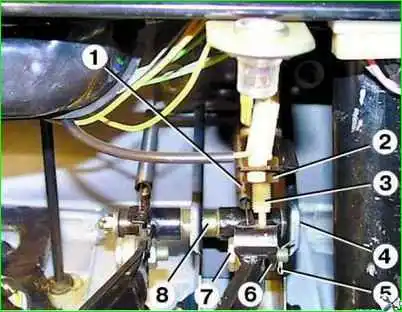Removing and installing the GAZ-3110 brake pedal
Remove the brake pedal to replace plastic bushings or for other work
Remove the clutch pedal
Disconnect return spring 1 from the brake pedal.

Remove the cotter pin 5, unscrew the fastening nut 6, remove the axle 7 and disconnect the connecting rod from the brake pedal, while removing the plastic bushings.
Unscrew the fastening nut 4, remove the pedal axle 8 and remove the brake pedal.
If it is necessary to replace the brake signal switch, you must disconnect the wire from the “negative” terminal of the battery, disconnect 3 wires from the switch and, unscrew the nut 2 fastening, remove the switch.
Installation
Install the brake pedal in the reverse order of removal.
In this case, it is necessary to lubricate the friction surfaces of the bushings and axle with a thin layer of graphite grease.
Inspection
The bushings must not have mechanical damage.
One-sided wear of the bushings indicates that there is unacceptable play in the pedal assembly, which in turn affects the full travel of the pedal.
Replace defective parts.
If the return spring has lost its elasticity, i.e. When the brake pedal is free, it does not reach the limiter; the spring must be replaced.
If the rubber lining of the brake pedal is significantly worn, it is recommended to replace it.
Adjusting the pedal
The brake pedal travel is adjusted by changing the length of the connecting rod.
To do this, you need to disconnect the rod from the pedal, loosen the nut of the rod adjustment unit and, turning the eye in the appropriate direction, achieve the desired result:
- the full travel of the brake pedal with the mat removed should be within 180–190 mm.
After adjustment, tighten the nut and connect the pusher to the pedal.
The free play of the brake pedal should be 3–5 mm.





